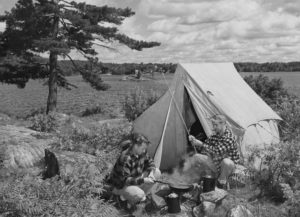ORIGINALLY PUBLISHED BY BORN TO RISE. When I was working as an academic archivist, a state Endangered Species Committee contacted me to review some family camping photos that we held. Somehow they’d gotten wind of a photographed, dated sighting “in the wild” of some kind of New England moss or flowering wort. We had the photo (it was actually a slide), dated in the 1940s.
The Endangered Species Committee was surprised to see that plant in that location at that time.
In the end, the committee tracked the shrinking presence of the moss or wort and moved it onto the endangered species list to protect it from extinction.
Many archived photos do have just such dramatic stories wrapped up in them. But the only way to capture, tell, and act on historic visual information is to save our photos…and preserve them.
Here are three different levels of information that we can get out of our family history images:
Content:
- Who is in the photos, pictorial record of them
- A record of your family, who is in it, and how they lived their lives.
- A record of what each generation felt was worthy of photographing.
Context also captured in the photo image:
- Visual evidence of a history of objects: clothing, cars, hairdos, clothes, shoes.
- Visual history of an event: a parade, an eclipse, or a president came to your town.
- Visual cultural evidence: What can we glean about the subjects’ cultural background? Do we see a church, school, club, or other telltale setting? Ethnic or holiday foods that would indicate an affiliation? Growth of a town over time?
Historic Object of the photo itself: Don’t toss your digitized photos!
- You can narrow down the date of a photo by its format, if you have 19th century photo styles such as Daguerrotypes, glass negatives, tintypes (iron), cartes de visite, or cabinet photos.
- The size of the print, thickness of the white border (if there is one), thickness of the paper it’s printed on, etc can all contribute to MORE information about the photo, when it was taken and processed, even what kind of camera was used. And knowing the camera can help pin down whether the photographer was a professional.
- Handwritten data MIGHT clarify who the subjects are (and who annotated the image), the date a photo was taken (as opposed to processed), and family provenance (path of ownership).
- Metadata printed on the photo … tossing original photos can mean the loss of all the markings on the photo related to processing, the photographer’s name, location & date, or even the processing date.
At Born to Rise Women’s Storytelling Festival in Tiverton, RI, on Saturday, September 17 @ 2:00 pm, I’ll host a photo preservation workshop to walk you through preserving one of your own photos. Bring an actual family/vintage/antique photo up to 8″x10″ and learn:
- three photo details to look for to help determine its date
-

Lakeside camping.
what details to add to the photo (and add them)
- what to write with, and when (archival quality pens and pencils supplied)
- how and why to encapsulate it in an archival polyester sleeve (& do it on site)
- what archival and access copies are — and leave with both!
You will feel more empowered to identify, understand, and keep the stories alive that live in your family photos.
This post was originally published in an email to the Born to Rise community, sent by the indomitable Kim Fuller, 9 September 2022.


 I spent 18 years as “archivist and senior research scholar” at an academic science library, actively trying to add women to the historical record and looking for the women who were already included almost accidentally. I have degrees in women’s history and cultural theory — the latter means that I see the cultural value of everyday practices such as food, clothing, hobbies, and domestic arrangements. Non-famous people matter.
I spent 18 years as “archivist and senior research scholar” at an academic science library, actively trying to add women to the historical record and looking for the women who were already included almost accidentally. I have degrees in women’s history and cultural theory — the latter means that I see the cultural value of everyday practices such as food, clothing, hobbies, and domestic arrangements. Non-famous people matter.